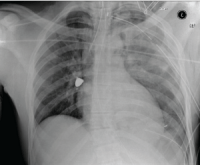-
Inaction on climate change has “jeopardized human life”: Report
A major new report into climate change shows that the human symptoms of climate change are unequivocal and that the delayed response to climate change over the past twenty-five years has jeopardized human life and livelihoods. The human symptoms of climate change are unequivocal and potentially irreversible – affecting the health of populations around the world today.
-
-
Evacuating a nuclear disaster area is often a waste of time and money, says study
Over 110,000 people were moved from their homes following the Fukushima nuclear disaster in Japan in March 2011. Another 50,000 left of their own will, and 85,000 had still not returned four-and-a-half years later. While this might seem like an obvious way of keeping people safe, my colleagues and I have just completed research that shows this kind of mass evacuation is unnecessary, and can even do more harm than good. We calculated that the Fukushima evacuation extended the population’s average life expectancy by less than three months. The reality is that, in most cases, the risk from radiation exposure if tpeople stay in their homes is minimal. It is important that the precedents of Chernobyl and Fukushima do not establish mass relocation as the prime policy choice in the future, because this will benefit nobody.
-
-
Study examines gun-related deaths and how to prevent them
A new study suggests various tactics for dealing with each metric of gun-related deaths. The suicide rate can be directly affected by decreasing firearm availability through safe storage practices, and the homicide rate may be decreased by preventing violent crime and deaths following a gun-related injury. Solutions for unintentional firearm-related deaths are linked mainly to education and safety precautions.
-
-
Infectious diseases: “Deleting” diseases from human bodies
Gene editing is revolutionizing the bioscience research landscape and holds great promise for “deleting” diseases from human bodies. Sandia National Laboratories is working to make this technology safer and to ensure that one day it can be delivered into humans without triggering adverse immune system reactions or causing other undesirable side effects.
-
-
Identifying biomarkers that indicate likelihood of survival in infected patients
Scientists have identified a set of biomarkers that indicate which patients infected with the Ebola virus are most at risk of dying from the disease. The findings could allow clinicians to prioritize the scarce treatment resources available and provide them to the sickest patients.
-
-
Radioactive material, leaked from a Russian nuclear complex, detected over Europe
The Russian state meteorological agency Roshydromet today released data which show exceedingly high atmospheric concentration of ruthenium-106 in the area where the Rosatom Mayak nuclear complex, located in the Southern Urals. The late-September leak, initially denied by Roasatom, the operator of the complex, caused the radioactive material to spread over northern Europe, where it was detected by IRSN and BfS, the French and German nuclear safety agencies, respectively.
-
-
Plague outbreak: where does it still exist, and could it spread?

An outbreak of plague has been occurring in Madagascar, with more than 2,000 cases and 170 deaths reported since August 2017. This island nation is one of the few remaining hotspots for plague in the world, with cases usually reported between September and April each year. It’s not possible to eradicate plague, as it is widespread in wildlife rodents outside the sphere of human influence. Outbreaks generally are managed reactively by “firefighting teams” deployed to clear houses of fleas, identify and treat cases and give pre-emptive treatment to contacts at risk. A more preventative approach, such as the identification of areas at risk using climate models and animal surveys to focus flea and rat control efforts would be better. But this requires a better understanding of transmission pathways in each region where disease persists.
-
-
Permissive concealed-carry laws tied to higher homicide rates
Easier access to concealed firearms is associated with significantly higher rates of handgun-related homicide, according to a new study. The study suggests that current trends towards more permissive concealed-carry laws are inconsistent with the promotion of public safety. “Some have argued that the more armed citizens there are, the lower the firearm homicide rate will be, because the feared or actual presence of armed citizens may deter violent crime,” said one of the authors. “Our study findings suggest that this is not the case.”
-
-
Severity of firearm injuries increased over the past 20 years

New research presented today at American Public Health Association’s (APHA) 2017 Annual Meeting and Expo revealed that the severity of firearm injuries has increased over the past twenty years, among those hospitalized for their injuries. Researchers noted that their findings have broad implications for public health beyond increased suffering on the individual level.
-
-
Improving public safety during severe weather, other disasters
Our ability to observe and predict severe weather events and other disasters has improved markedly over recent decades, yet this progress does not always translate into similar advances in the systems used in such circumstances to protect lives. A more cohesive alert and warning system that integrates public and private communications mechanisms and adopts new technologies quickly is needed to deliver critical information during emergency situations. At the same time, better understanding of social and behavioral factors would improve the ways we communicate about hazards, inform response decisions such as evacuations, develop more resilient urban infrastructure, and take other steps to improve weather readiness.
-
-
Sandia’s international peer mentorship program improves management of biorisks
The world is becoming increasingly interconnected. While this has definite advantages, it also makes it easier to spread disease. Many diseases don’t produce symptoms for days or weeks, far longer than international flight times. For example, Ebola has an incubation period of two to twenty-one days. Improving biosafety practices around the world to prevent the spread of diseases to health care workers and biomedical researchers is an important part of halting or minimizing the next pandemic, said Eric Cook, a Sandia National Laboratories biorisk management expert.
-
-
WannaCry report shows NHS chiefs knew of security danger, but management took no action
A report from the parliamentary National Audit Office into the WannaCry ransomware attack that brought down significant parts of Britain’s National Health Service in May 2017 has predictably been reported as blaming NHS trusts and smaller organizations within the care system for failing to ensure that appropriate computer security measures such as software updates and secure firewalls were in place. But the central NHS IT organization, NHS Digital, provided security alerts and the correct patches that would have protected vulnerable systems well before WannaCry hit. This is not a cybersecurity failure in the practicalities, but a failure of cybersecurity management at the top level.
-
-
North Korea behind May 2017 WannaCry attack on British health services: U.K.
The British government has said it was all but certain North Korea carried out the “WannaCry” malware attack which hobbled the IT systems of the NHS, Britain’s national health service, in May. The National Audit Office (NAO) released a report on Friday which found that hospitals and clinics were left exposed to cyberattack because they failed to follow basic cybersecurity recommendations. WannaCry attacks were not limited to the United Kingdom: More than 300,000 computers in 150 countries were also infected with the WannaCry ransomware. The malware crippled organizations — government agencies, global companies, small firms — by targeting computers with outdated security.
-
-
More than 1,300 suspected plague cases reported in Madagascar
The World Health Organization (WHO) reported a total of 1,309 suspected cases, including 93 deaths, in an update 27 October on the plague outbreak in Madagascar. The case-fatality rate for the outbreak is now 7 percent. The numbers reflect an increase of 12 cases and 9 fewer deaths from the WHO’s previous update on 20 October.
-
-
The dangerous combination of civil war and threat of global pandemics
There are thirty civil wars underway around the globe, where civilians are dealing with death and destruction as well as public health emergencies exacerbated by the deadly march of conflict. And yet today, of the nearly 200 countries on this planet, only six nations — three rich ones and three poor ones — have taken steps to evaluate their ability to withstand a global pandemic. “The bottom line is that despite the profound global threat of pandemics, there remains no global health mechanism to force parties to act in accordance with global health interests,” says one expert. “The unpredictability of a serious infectious outbreak, the speed with which it can disseminate, and the fears of domestic political audience can together create a powerful destabilizing force,” says another.
-
More headlines
The long view
Are We Ready for a ‘DeepSeek for Bioweapons’?
Anthropic’s Claude 4 is a warning sign: AI that can help build bioweapons is coming, and could be widely available soon. Steven Adler writes that we need to be prepared for the consequences: “like a freely downloadable ‘DeepSeek for bioweapons,’ available across the internet, loadable to the computer of any amateur scientist who wishes to cause mass harm. With Anthropic’s Claude Opus 4 having finally triggered this level of safety risk, the clock is now ticking.”
A Brief History of Federal Funding for Basic Science
Biomedical science in the United States is at a crossroads. For 75 years, the federal government has partnered with academic institutions, fueling discoveries that have transformed medicine and saved lives. Recent moves by the Trump administration — including funding cuts and proposed changes to how research support is allocated — now threaten this legacy.
Vaccine Integrity Project Says New FDA Rules on COVID-19 Vaccines Show Lack of Consensus, Clarity
Sidestepping both the FDA’s own Vaccines and Related Biological Products Advisory Committee and the CDC’s Advisory Committee on Immunization Practices (ACIP), two Trump-appointed FDA leaders penned an opinion piece in the New England Journal of Medicine to announce new, more restrictive, COVID-19 vaccine recommendations. Critics say that not seeking broad input into the new policy, which would help FDA to understand its implications, feasibility, and the potential for unintended consequences, amounts to policy by proclamation.
